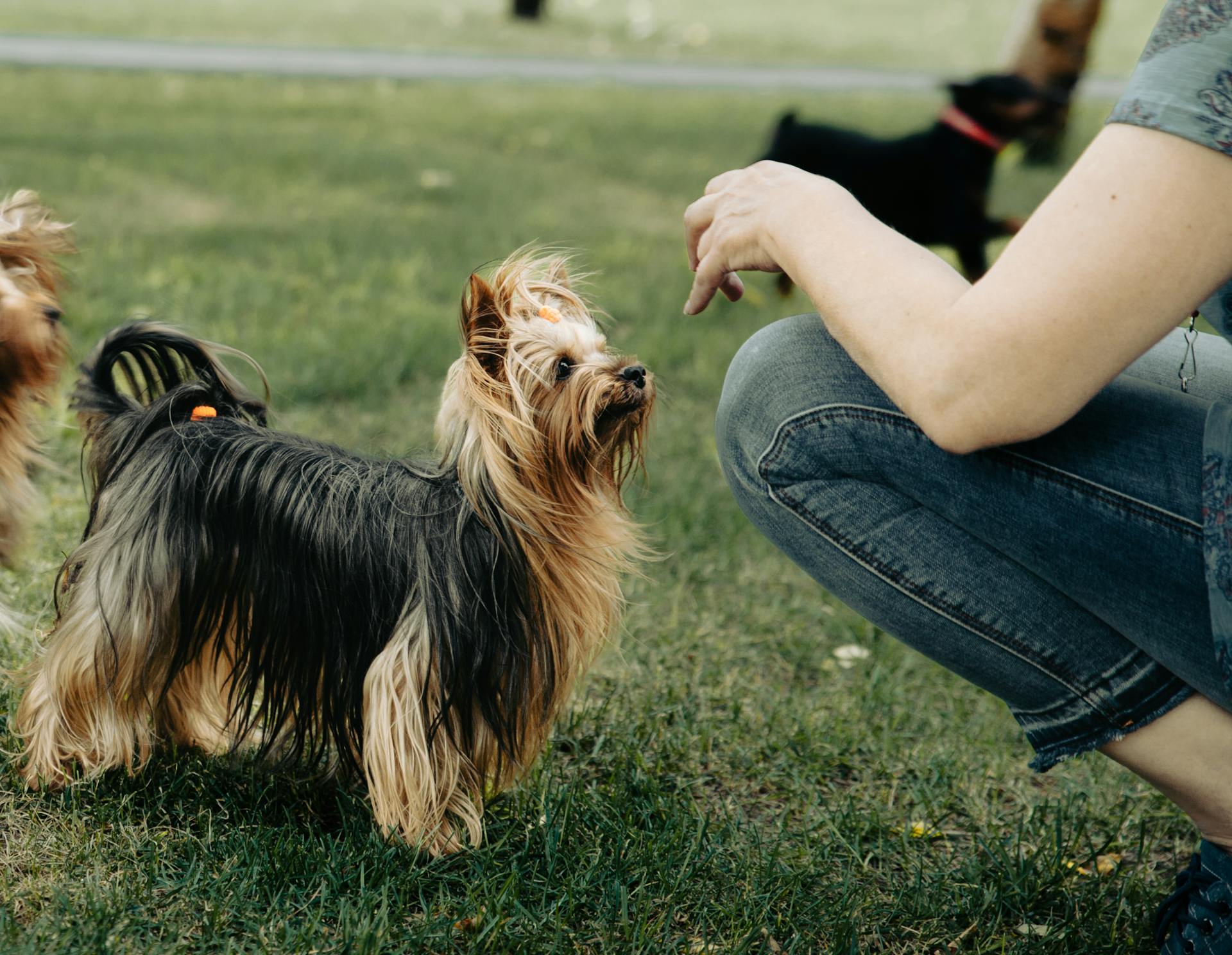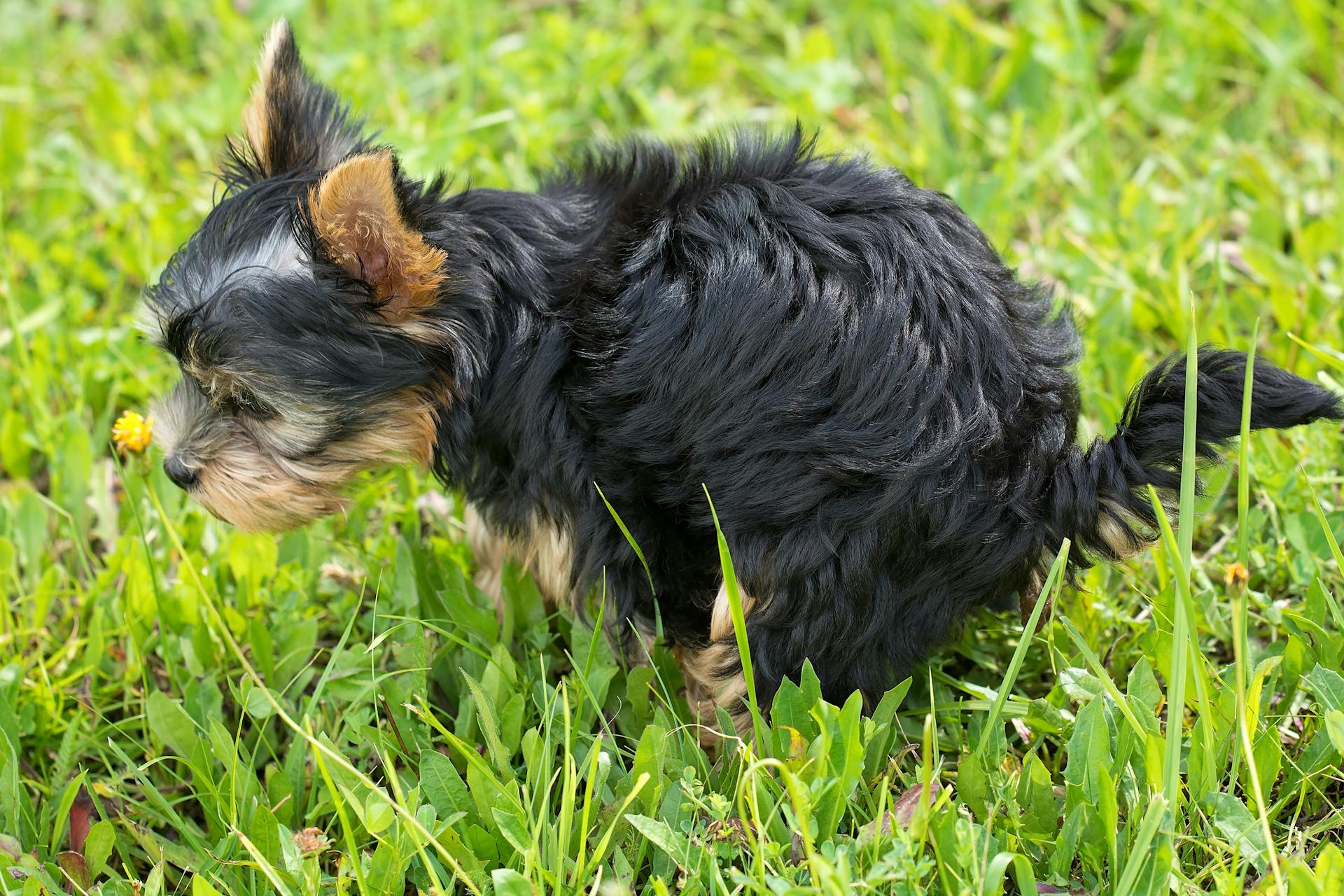
The Silky Terrier is a small dog breed that originated in Australia and is known for its silky, fine coat. They typically weigh between 8-11 pounds and stand between 9-10 inches tall.
These dogs are friendly and affectionate, making them great companions for families with children. They are also relatively low-maintenance when it comes to exercise, requiring only short daily walks to stay happy and healthy.
One of the standout features of the Silky Terrier is its beautiful coat, which requires regular grooming to prevent matting and tangling. This can be a bit time-consuming, but it's worth it to keep their coat looking its best.
Physical Characteristics
The Silky Terrier is a small dog, typically standing between 9 to 10 inches tall at the withers.
They have a compact, slightly low set body, with fine but strong bone, making them well-suited for hunting and killing domestic rodents.
Their weight is proportionate to their height, and they require regular grooming to maintain their silky coat.
The Silky Terrier's head is strong and Terrier-like, with a moderately long muzzle that is slightly less than the length of the skull.
Their coat is long, but not floor-length, and comes in various shades of blue and tan, including pigeon-blue, slate-blue, and black and tan.
Their movement is free, light-footed, and lively, with an easy, effortless gait that requires powerful hindquarters.
General Appearance
The Silky Terrier is a small dog, typically standing between 9.1 to 10.2 inches tall at the withers. It's compact and slightly low set, with a moderately low set body that's somewhat longer than tall.
Its weight is not explicitly stated in the article sections, but its substance is sufficient to allow it to hunt and kill domestic rodents. This suggests that the Silky Terrier has a sturdy build despite its small size.
The Silky Terrier's head is strong and Terrier in characteristics, with a moderate length and a muzzle that's slightly less than the length of the skull. Its eyes are small and almond-shaped, with light-colored eyes considered a fault.
The Silky Terrier's coat is one of its most distinctive features, coming in shades of blue and tan and requiring regular grooming to maintain its silkiness. The coat should be long but not floor length, with the hair on the face and ears normally cut.
Forequarters

The forequarters of a dog are a crucial part of its overall physical structure, and they play a vital role in its movement and agility.
The well-laid-back shoulders are a key characteristic of a well-built forequarter, providing a stable base for the dog's movement.
Proper angulation of the upper arm is essential, as it allows the forelegs to be nicely placed under the body, giving the dog a balanced and efficient gait.
Height and Weight
When it comes to height, our furry friends typically range from 9 to 10 inches at the withers, and any deviation in either direction is not ideal.
Height is directly related to weight, and a correct balance of substance is crucial.
A balanced weight is proportionate to their height, so it's essential to ensure they're not too thin or too heavy.
Deviation from the ideal weight can be a sign of an underlying health issue, so regular check-ups with a vet are a must.
Temperament and Behavior
Australian Silky Terriers are naturally alert and active, but they're also happy to lounge around with their family, keeping a watchful eye out for any potential threats.
They're intelligent and respond well to training, so it's essential to start teaching basic obedience commands from a young age.
Silky Terriers bond strongly with their family members and demand attention constantly, which means they thrive on human interaction and can get bored if left alone for too long.
They're a bit wary of strangers at first, but once they get to know them, they're quick to warm up.
Exercise is crucial for Silky Terriers, as they require regular physical and mental stimulation to prevent boredom and destructive behavior.
If they don't get enough attention and exercise, they might resort to barking, digging, or chewing, so it's vital to ensure they're getting the attention they crave.
Silky Terriers do best in households with older children, as they can be a bit too energetic for toddlers and might snap or nip if they're not in the mood for play.
However, with proper supervision and training, Silky Terriers can make excellent family pets for active families who can provide them with the attention and exercise they need.
Health and Care
Silky terriers are generally a healthy breed, but like all dogs, they can be prone to certain health issues. On average, they can live for around 12-15 years.
A 2024 UK study found that silky terriers have a life expectancy of 13.3 years, which is higher than some other breeds. However, they can still develop health problems if not properly cared for.
Regular exercise and training are essential for silky terriers, and they require daily attention and socialization. Their grooming needs can also be time-consuming, depending on how long you keep their coat.
Here are some common health issues that can affect silky terriers:
Health and Conditions
The Silky Terrier is a generally healthy breed, but like all breeds, it's not immune to certain health issues. A 2024 UK study found that the breed has a life expectancy of 13.3 years, which is significantly higher than the average life expectancy of 12 for crossbreeds.
Curious to learn more? Check out: Welsh Terrier Life Span

Arthritis and cataracts are common health problems that can affect Silky Terriers in old age. Proper care and regular veterinary check-ups can help prevent or manage these issues.
The breed is prone to patellar luxation, which is a condition where the kneecap slips out of place. This can be painful for the dog and may require surgery to correct.
A balanced diet and regular exercise can help prevent dental disease, which is another common health issue affecting Silky Terriers. Regular brushing and dental check-ups can also help prevent this condition.
Here's a list of some potential health issues that can affect Silky Terriers:
- Patellar luxation
- Cataracts
- Eye problems
These health issues can be managed with proper care and veterinary attention. Regular check-ups and preventative care can help ensure that your Silky Terrier lives a long and healthy life.
Care
To keep your Silky Terrier happy and healthy, they need daily exercise to stay physically and mentally stimulated.
Regular training and socialization are also essential, starting from an early age to help them develop good behavior and interact well with people and other animals.
Their grooming can be a significant time investment, especially if you choose to keep their coat long.
Grooming
The Silky Terrier's coat is a real showstopper, with its glossy, long, and silky texture that's similar to human hair.
Regular grooming is essential to prevent matting and tangles, and it's recommended to brush the coat at least twice a week, or daily if the coat is long.
You'll need to use a pin brush, soft-bristle brush, or comb to work out tangles and prevent mats.
Bathing the Silky Terrier every 4 to 6 weeks is a good rule of thumb, along with a coat trim to keep the coat looking its best.
Don't forget to check the ears weekly for wax buildup and irritation, and brush the teeth daily to keep up with dental hygiene.
Trimming the nails regularly is also important, and it's a good idea to do this when bathing the Silky Terrier.
If you're not comfortable with the grooming requirements, you may want to consider taking your Silky Terrier to a professional groomer.
Frequently Asked Questions
Are silky Terriers and Yorkies the same?
Silky Terriers and Yorkies are not the same, but they share similarities as both are toy dogs with distinct characteristics. While they may look alike, Silky Terriers are slightly larger and have a unique appearance.
Do silky Terriers bark a lot?
Yes, Silky Terriers are known to bark frequently, often to alert their owners to visitors or to demand attention. This barking behavior is a natural trait of the breed.
What is the difference between a silky and a Yorkie?
The Silky and Yorkie have distinct physical differences, including a wedge-shaped head, larger teeth, and uniquely shaped ears. These differences set the Silky apart from the more rounded-skulled Yorkie.
Are Australian silky terriers smart?
Yes, Australian Silky Terriers are highly intelligent dogs known for their spirited and clever nature. Their intelligence makes them a joy to train and interact with.
Are silky Terriers good family dogs?
Yes, Silky Terriers can make great family dogs, especially when socialized properly from an early age. With proper training and socialization, they're loving and gentle companions for families with children and other pets.
Featured Images: pexels.com

